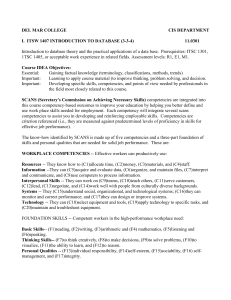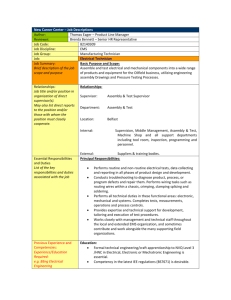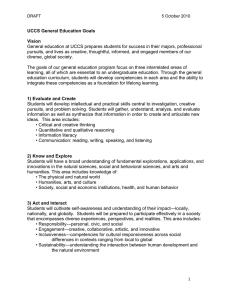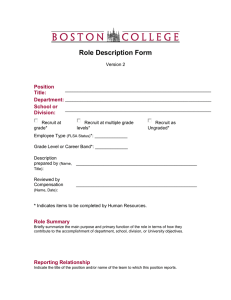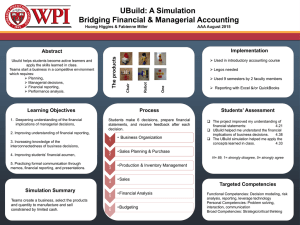Post-installation and day-to-day administration tasks of various network operating
advertisement
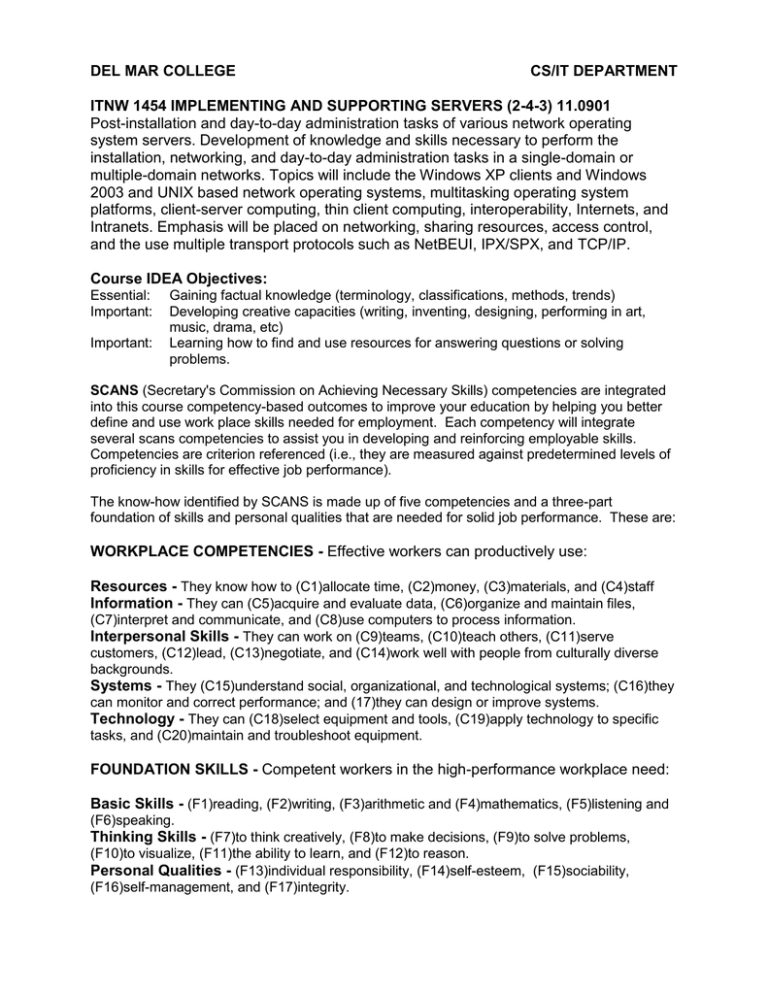
DEL MAR COLLEGE CS/IT DEPARTMENT ITNW 1454 IMPLEMENTING AND SUPPORTING SERVERS (2-4-3) 11.0901 Post-installation and day-to-day administration tasks of various network operating system servers. Development of knowledge and skills necessary to perform the installation, networking, and day-to-day administration tasks in a single-domain or multiple-domain networks. Topics will include the Windows XP clients and Windows 2003 and UNIX based network operating systems, multitasking operating system platforms, client-server computing, thin client computing, interoperability, Internets, and Intranets. Emphasis will be placed on networking, sharing resources, access control, and the use multiple transport protocols such as NetBEUI, IPX/SPX, and TCP/IP. Course IDEA Objectives: Essential: Important: Important: Gaining factual knowledge (terminology, classifications, methods, trends) Developing creative capacities (writing, inventing, designing, performing in art, music, drama, etc) Learning how to find and use resources for answering questions or solving problems. SCANS (Secretary's Commission on Achieving Necessary Skills) competencies are integrated into this course competency-based outcomes to improve your education by helping you better define and use work place skills needed for employment. Each competency will integrate several scans competencies to assist you in developing and reinforcing employable skills. Competencies are criterion referenced (i.e., they are measured against predetermined levels of proficiency in skills for effective job performance). The know-how identified by SCANS is made up of five competencies and a three-part foundation of skills and personal qualities that are needed for solid job performance. These are: WORKPLACE COMPETENCIES - Effective workers can productively use: Resources - They know how to (C1)allocate time, (C2)money, (C3)materials, and (C4)staff Information - They can (C5)acquire and evaluate data, (C6)organize and maintain files, (C7)interpret and communicate, and (C8)use computers to process information. Interpersonal Skills - They can work on (C9)teams, (C10)teach others, (C11)serve customers, (C12)lead, (C13)negotiate, and (C14)work well with people from culturally diverse backgrounds. Systems - They (C15)understand social, organizational, and technological systems; (C16)they can monitor and correct performance; and (17)they can design or improve systems. Technology - They can (C18)select equipment and tools, (C19)apply technology to specific tasks, and (C20)maintain and troubleshoot equipment. FOUNDATION SKILLS - Competent workers in the high-performance workplace need: Basic Skills - (F1)reading, (F2)writing, (F3)arithmetic and (F4)mathematics, (F5)listening and (F6)speaking. Thinking Skills - (F7)to think creatively, (F8)to make decisions, (F9)to solve problems, (F10)to visualize, (F11)the ability to learn, and (F12)to reason. Personal Qualities - (F13)individual responsibility, (F14)self-esteem, (F15)sociability, (F16)self-management, and (F17)integrity. II. Learning Outcomes: The student will be able to explain and perform the processes necessary to create and manage user accounts and groups; set up and administer permission for files and folder; set up, administer, and troubleshoot network printing; monitor and manage network resources and security; and back up and restore files and folders, the roles of Network Operating Systems and the various hardware and software components of a domain-based network by completing the following: Competency-based outcomes: Competencies: A.) Research online resources to identify the several types of network operating systems and how they interact with computer hardware and software and network infrastructure communication under the OSI Model. B.) Describe the features of various Network Operating Systems, including their different revisions, by developing charts, surveys and a written composition to recommend the correct choice based for a given use. C.) Install and configure network servers and clients both locally and remotely. D.) Work individually and in groups to discuss and outline the implementation of each of the Network Operating Systems, including hardware requirements and environmental considerations. E.) Summarizes articles from various online sources that identify current virus threats to the Network Operating Systems and the preventative measures that should be implemented to prevent their occurrence. F.) Describe the various devices used in the transmission of data in a network and their appropriate uses in a network infrastructure design. G.) Describe the three components of a network and configuration requirements for a TCP/IP network DHCP and DNS. H.) Research and describe the various types of media used in network implementation. I.) Compare the differences between peer-to-peer and domain-based networks and identify the advantages and disadvantages of implementing each and/or both networks in various situations including the set up of users, groups, policies, and profiles. J.) Create both physical and logical network designs for various types of networks to include the remote access of the network. K.) Research the use of Server Clustering and present a written description of the benefits of implementing a Server Cluster. L.) Working in teams, describe the implementation of the various Network Operating Systems and develop an implementation plan for a domain-based network using the various Network Operating Systems and set up and maintain a logon security and security for files and printers M.) Through discussion groups, identify major security threats to computer networks and the role of Network Operating Systems in minimizing these threats. N.) Research the use of a UPS and backup procedures. And, through group participation, analyze the process for implementing a disaster recovery plan. O.) Through small group participation, create a PowerPoint presentation on a topic related to an element of Network Infrastructure design, including system security and its implementation in a domain-based network P.) In lab assignments, demonstrate the ability to: a) Install and/or upgrade a server with each of the Network Operating Systems studied. b) Configure each Network Operating System and connect a variety of clients running various client operating systems in a domain-based network c) Create and manage user and group accounts d) Configure and manage disks and partitions. e) Implement available security settings for each operating system using PKI and IPSec. f) Configure printing services for use on a domain-based network. g) Configure a DHCP, a DNS, and an IIS Server Evaluation: To demonstrate mastery of the competencies listed above, the student will be responsible for: 1) Completing class project using instructional material and lecture notes. 2) Completing required tests and network design assignments. 3) Writing and presenting a series of papers on identified Network Operating System Infrastructure design topics. 4) Create and present a PowerPoint presentation on an identified Network Operating System Infrastructure design topic. 5) Actively participating and completing individual and group lab projects 6) Actively participating in class discussions To facilitate mastery of above listed competencies, the instructor will be responsible for: 1) 2) 3) 4) 5) 6) 7) 8) 9) Gaining student's attention Informing student of objectives Stimulating recall of prior knowledge Presenting new material Providing guided practice Eliciting performance Providing feedback Assessing performance Enhancing retention and transfer of knowledge. COMPETENCY-BASED OUTCOMES WITH WORKPLACE PROFICIENCY LEVELS Resources Information Interpersonal Skills Systems Technology A B C D E F G H I J K L M N O P C 1 C 2 C 3 C 4 C 5 C 6 C 7 C 8 C 9 C 10 C 11 C 12 C 13 C 14 C 15 C 16 C 17 C 18 C 19 C 20 3 3 3 3 3 3 3 3 3 3 3 3 3 3 3 3 3 3 3 3 3 3 3 3 3 3 3 3 3 3 3 3 4 4 4 4 4 4 4 4 4 4 4 4 4 4 4 4 3 3 3 3 3 3 3 3 3 3 3 3 3 3 3 3 3 4 4 4 3 3 3 4 4 3 4 4 3 4 4 3 4 4 4 4 4 4 4 4 4 4 4 4 4 4 4 4 3 3 3 3 3 3 3 4 3 3 3 3 3 3 3 3 4 4 4 4 4 4 4 4 4 4 4 4 4 4 4 4 3 3 3 4 3 3 3 3 3 4 3 3 3 3 3 3 3 3 3 3 3 3 3 3 4 4 4 4 3 4 4 3 3 3 3 3 3 3 3 3 4 3 4 4 3 4 4 3 3 3 3 3 3 3 3 3 3 3 3 3 3 3 3 3 3 3 3 3 3 3 3 3 3 3 3 3 3 3 3 3 3 3 3 3 3 3 3 3 3 3 3 3 3 3 3 3 3 3 3 4 4 3 4 3 4 4 4 4 3 4 4 3 3 3 3 3 3 3 3 3 4 4 4 4 3 4 4 3 3 3 3 3 3 3 3 3 4 4 4 4 3 4 4 3 3 3 3 3 3 3 3 3 3 3 3 3 3 3 3 3 4 4 4 4 4 4 4 4 4 4 4 4 4 4 4 4 3 3 3 3 3 3 3 3 3 3 3 3 3 3 3 3 COMPETENCY-BASED OUTCOMES WITH FOUNDATION SKILLS LEVELS Basic Skills Thinking Skills Personal Qualities F F F F F F F F F F F F F F F F F 1 2 3 4 5 6 7 8 9 10 11 12 13 14 15 16 17 A 4 4 3 3 3 4 3 3 3 3 3 3 3 3 3 3 3 B 4 4 3 3 3 4 3 3 3 4 4 3 3 3 3 3 3 C 4 4 3 3 3 4 3 3 3 4 4 4 4 3 4 4 4 D 4 4 3 3 3 4 3 3 3 4 4 4 4 3 4 4 4 E 4 4 3 3 3 4 3 3 3 4 4 3 3 3 3 3 3 F 4 4 3 3 3 4 3 3 3 4 4 4 4 3 4 4 4 G 4 4 3 3 3 4 3 3 3 4 4 4 4 3 4 4 4 H 4 4 3 3 3 4 3 3 3 4 4 4 4 3 4 4 4 I 4 4 3 3 3 4 3 3 3 4 4 4 4 3 4 4 4 J 4 4 3 3 3 4 3 3 3 4 4 3 3 3 3 3 3 K 4 4 3 3 3 4 3 3 3 4 4 4 4 3 4 4 4 L 4 4 3 3 3 4 3 3 3 3 3 3 3 3 3 3 3 M 4 4 3 3 3 4 3 3 3 4 4 4 4 3 4 4 4 N 4 4 3 3 3 4 3 3 3 4 4 4 4 3 4 4 4 O 4 4 3 3 3 4 3 3 3 4 4 4 4 3 4 4 4 P 4 4 3 3 3 4 3 3 3 4 4 4 4 3 4 4 4 1 rarely performs task 2 3 4 5 Routinely performs task w/moderate supervision Routinely performs task w/minimal supervision Routinely performs task Routinely performs task over/ beyond designated task
